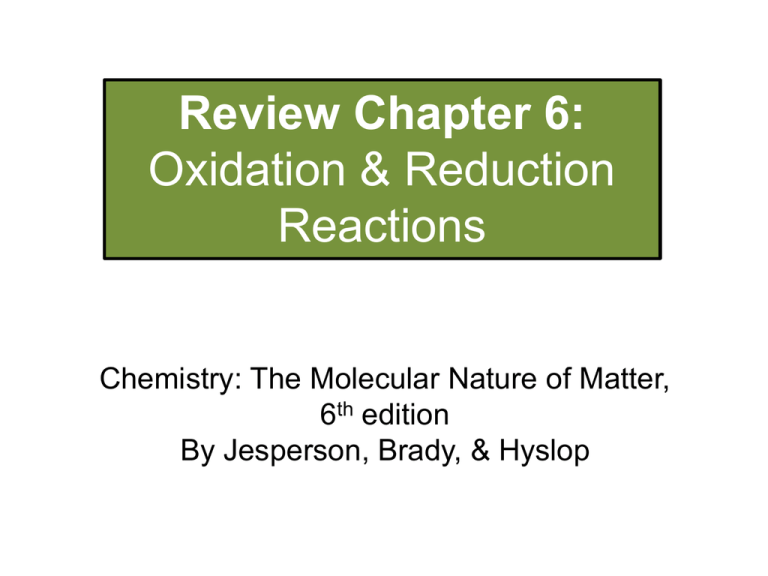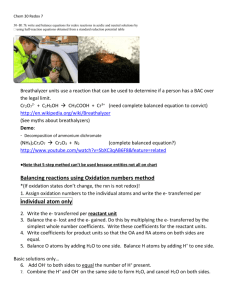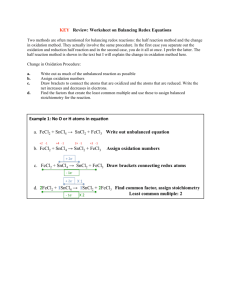Review Chapter 6: Oxidation & Reduction Reactions Chemistry: The Molecular Nature of Matter,
advertisement

Review Chapter 6: Oxidation & Reduction Reactions Chemistry: The Molecular Nature of Matter, 6th edition By Jesperson, Brady, & Hyslop Chapter 6 Concepts Be very familiar with the difference between oxidation and reduction Identify a redox reaction (look for changing oxidation numbers) Determine oxidation numbers and identify oxidizing and reducing agents Balance redox reactions either using The half reaction method (ion-electron method) The atom conservation method Predict the products of: Combustion reactions Single replacement reactions acids as oxidizing agents Recognize combustion, corrosion, and single replacement reactions 2 Define Oxidation & Reduction Oxidation = loss of electrons Reduction = gain electrons An oxidizing agent is reduced as it oxidizes another compound A reducing agent is oxidized as it reduces another compound A redox reaction always has one one element being oxidized and another being reduced, identifying these confirms the reaction is a redox reaction. Memorize: Rules for Assigning Ox # 1. 2. 3. 4. 5. 6. 7. 8. 9. Assigning Oxidation Numbers Oxidation numbers must add up to charge on molecule, formula unit or ion. Atoms of free elements have oxidation numbers of zero. Metals in Groups 1A, 2A, and Al have +1, +2, and +3 oxidation numbers, respectively. H and F in compounds have +1 and –1 oxidation numbers, respectively. Oxygen has –2 oxidation number. Group 7A elements have –1 oxidation number. Group 6A elements have –2 oxidation number. Group 5A elements have –3 oxidation number. When there is a conflict between two of these rules or ambiguity in assigning an oxidation number, apply rule with lower oxidation number and the rule higher on this priority list, and ignore conflicting rule Memorize: Balanced Redox Reactions The Half-Reaction Method: 1. Divide equation into two half-reactions 2. Balance atoms other than H and O 3. Balance O by adding H2O to side that needs O 4. Balance H by adding H+ to side that needs H 5. Balance net charge by adding e– 6. Make electron gain equal electron loss; then add half-reactions 7. Cancel electrons and anything that is the same on both sides If balancing in basic conditions: 8. Add the same number of OH– to both sides of the equation as there are H+ 9. Combine H+ and OH– to form H2O 10. Cancel any H2O that you can from both sides Memorize: Balanced Redox Reactions The Atom-Conservation Method: 1. Identify the side of the reaction with greater negative charge (ie, more anions) and add H+. 2. On the opposite side of the reaction from where the H+ was added include H2O to balance out the new hydrogen atoms. 3. Assign variables to the coefficients in front of every molecule or compound. 4. Set up equations for each element in the reaction setting the sum of the atoms on the reactant side of the equation equal to the sum of the atoms on the product side of the equation. Include an equation describing the charge balance of the reaction. 5. Chose a variable and assume it is equal to 1. 6. Solve the remaining equations. 7. Multiply all of the coefficients by the same number to ensure they are all whole numbers. If balancing in basic conditions: 8. Add the same number of OH– to both sides of the equation as there are H+ 9. Combine H+ and OH– to form H2O 10. Cancel any H2O that you can from both sides Types of Redox Reactions Combustion Excess oxygen: CxHy + O2 CO2 + H2O Excess oxygen: CxHySz + O2 CO2 + H2O + SO2 Limited oxygen: CxHy + O2 CO + H2O Very Limited oxygen: CxHy + O2 C + H2O Corrosion Metal: M (s) + O2 (g) MxOy Nonmetal: S (s) + O2 (g) SO2 N (g) + O2 (g) NO or NO2 or N2O or N2O3 or N2O4 or N2O5 Single Replacement M (s) + NxBy (aq) MwBz (aq) + N (s) • where M and N are either metals or nonmetals Acids as Oxidizing Agents Acids: HA = H+ + AH+ is a stronger oxidizing agent then A- A- is a stronger oxidizing agent then H+ Non-Oxidizing Acids Oxidizing Acids A- H+ H2 (g) H+ is the oxidizing agent H2 is the reduction product Examples: HCl, HBr, HI Organic Acids (CH3CO2H) H3PO4 H2SO4 if cold & dilute A- reduction product H2SO4 With Strong Reducing Agent: H2SO4 H2S (g) With a Moderate or Weak Reducing Agent: H2SO4 SO2 (g) HNO3 Concentrated: NO3– NO2 (g) Dilute: NO3– NO (g) Be Familiar with Activity Series M (s) + NxBy (aq) MwBz (aq) + N (s) If M and N are both metals then M = element and N = Oxidizing Agent Element Oxidizing Agent Rxn Will Occur Rxn Won’t Occur






